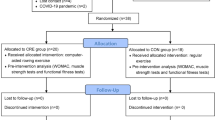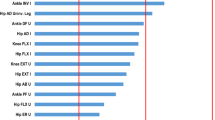Abstract
Aim
The aim of this study was to compare proprioceptive function between computerized proprioception facilitation exercise (CPFE) and closed kinetic chain exercise (CKCE) for knee osteoarthritis.
Design
Randomized–controlled.
Setting
Kinesiology laboratory.
Patients
Eighty-one patients with bilateral knee osteoarthritis were randomly assigned to CPFE, CKCE, and control groups.
Intervention
Both exercise groups underwent an 8-week program of three sessions per week. The control group received no training. The CPFE program included a 20-min computer game to be played by the trained foot of the subject. CKCE included 10 sets of 10 repetitions of repeated knee extension and flexion with resistance of 10–25% of body weight.
Main outcome measures
Absolute reposition error, functional score, walking speed, and knee muscle strength were assessed with an electrogoniometer, the physical function subscale of Western Ontario and McMaster Osteoarthritis Index, a CASIO stopwatch, and a Cybex 6000 dynamometer before and after the 8-week period.
Results
The results of this study showed that both CPFE and CKCE were effective in improving joint position sense, functional score, walking speed, and muscle strength. Furthermore, CKCE showed greater effect in increasing knee extensor torque in patients with knee osteoarthritis.
Conclusion
Clinical effects of CPFE were the same as those of CKCE except for knee extensor torque. The increase in knee extensor torque in CPFE patients was not as great as that seen in CKCE patients.




Similar content being viewed by others
References
Eyigor S, Hepguler S, Capaci K (2004) A comparison of muscle training methods in patients with knee osteoarthritis. Clin Rheumatol 23:109–115
Vilalta C, Nunez M, Segur JM, Domingo A, Carbonell JA, Macule F (2004) Knee osteoarthritis: interpretation variability of radiological signs. Clin Rheumatol 23:501–504
Koralewicz LM, Engh GA (2000) Comparison of proprioception in arthritic and age-matched normal knees. J Bone Joint Surg Am 82:1582–1588
Lord SR, Clark RD, Webster IW (1991) Physical factors associated with falls in an elderly population. J Am Geriatr Soc 39:1194–1200
Marks R, Quinney HA, Wessel J (1993) Proprioceptive sensibility in women with normal and osteoarthritic knee joints. Clin Rheumatol 12:170–175
Bearne LM, Scott DL, Hurley MV (2002) Exercise can reverse quadriceps sensorimotor dysfunction that is associated with rheumatoid arthritis without exacerbating disease activity. Rheumatology 41:157–166
Geffen SJ (2003) Rehabilitation principles for treating chronic musculoskeletal injuries. Med J Aust 178:238–242
Borsa PA, Lephart SM, Irrgang JJ, Safran MR, Fu FH (1997) The effects of joint position and direction of joint motion on proprioceptive sensibility in anterior cruciate ligament-deficient athletes. Am J Sports Med 25:336–340
Lephart SM, Pincivero DM, Giraldo JL, Fu FH (1997) The role of proprioception in the management and rehabilitation of athletic injuries. Am J Sports Med 25:130–137
Lephart SM, Pincivero DM, Rozzi SL (1998) Proprioception of the ankle and knee. Sports Med 25:149–153
Ribot-Ciscar E, Roll JP (1998) Ago-antagonist muscle 1 spindle inputs contribute together to joint movement coding in man. Brain Res 791:167–176
Schmidt RA (1999) Sensory contributions to motor control. In: Schmidt RA, Lee TD (eds) Motor control and learning: a behavioral emphasis, 3rd edn. Human Kinetics, Champaign, pp 95–129
Jan MH, Lai JS (1991) The effect of physiotherapy on osteoarthritis knees of females. J Formos Med Assoc 90:1008–1013
Hurley MV, Scott DL (1998) Improvements in quadriceps sensorimotor function and disability of patients with knee osteoarthritis following a clinically practicable exercise regime. Br J Rheumatol 37:1181–1187
Baker V, Bennell K, Stillman B, Cowan S, Crossley K (2002) Abnormal knee joint position sense in individuals with patellofemoral pain syndrome. J Orthop Res 20:208–214
Kramer J, Handfield T, Kiefer G, Forwell L, Birmingham T (1997) Comparisons of weight-bearing and non-weight-bearing tests of knee proprioception performed by patients with patello-femoral pain syndrome and asymptomatic individuals. Clin J Sport Med 7:113–118
Baliunas AJ, Hurwitz DE, Ryals AB, Karrar A, Case JP, Block JA (2002) Increased knee joint loads during walking are present in subjects with knee osteoarthritis. Osteoarthritis Cartilage 10:573–579
Lucchinetti E, Adams CS, Horton WE, Torzilli PA (2002) Cartilage viability after repetitive loading. Osteoarthritis Cartilage 10:71–81
Kellgren JH, Lawrence JS (1957) Radiological assessment of osteoarthrosis. Ann Rheum Dis 16:494–501
Kohatsu ND, Schurman DJ (1990) Risk factors for the development of osteoarthrosis of the knee. Clin Orthop 261:242–246
Tuzun EH, Eker L, Aytar A, Daskapan A, Bayramoglu M (2005) Acceptability, reliability, validity and responsiveness of the Turkish version of WOMAC osteoarthritis index. Osteoarthritis Cartilage 13(1):28–33
Dvir Z (1996) Isokinetics. Churchill Livingstone, New York
Shima N, Ishida K, Katayama K, Morotome Y, Sato Y, Miyamura M (2002) Cross education of muscular strength during unilateral resistance training and detraining. Eur J Appl Physiol 86:287–294
Gur H, Cakin N (2003) Muscle mass, isokinetic torque, and functional capacity in women with osteoarthritis of the knee. Arch Phys Med Rehabil 84:1534–1541
Stensdotter AK, Hodges PW, Mellor R, Sundelin G, Hager-Ross C (2003) Quadriceps activation in closed and in open kinetic chain exercise. Med Sci Sports Exerc 35:2043–2047
Bouet V, Gahery Y (2000) Muscular exercise improves knee position sense in humans. Neurosci Lett 289:143–146
Hewett TE, Paterno MV, Myer GD (2002) Strategies for enhancing proprioception and neuromuscular control of the knee. Clin Orthop 402:76–94
Padoa-Schioppa C, Li CS, Bizzi E (2004) Neuronal activity in the supplementary motor area of monkeys adapting to a new dynamic environment. J Neurophysiol 91:449–473
Morgen K, Kadom N, Sawaki L, Tessitore A, Ohayon J, Frank J et al (2004) Kinematic specificity of cortical reorganization associated with motor training. Neuroimage 21:1182–1187
Ashton-Miller JA, Wojtys EM, Huston LJ, Fry-Welch D (2001) Can proprioception really be improved by exercises? Knee Surg Sports Traumatol Arthrosc 9:128–136
Hurley MV, Scott DL, Rees J, Newham D (1997) Sensorimotor 1 changes and functional performance in patients with knee osteoarthritis. Ann Rheum Dis 56:641–648
Sharma L (1999) Proprioception impairment in knee osteoarthritis. Rheum Dis Clin North Am 25:299–314
McAlindon TE, Cooper C, Kirwan JR, Dieppe PA (1993) Determinants of disability in osteoarthritis of the knee. Ann Rheum Dis 52:258–262
Riener R, Rabuffetti M, Frigo C (2002) Stair ascent and descent at different inclinations. Gait Posture 15:32–44
Acknowledgement
Financial support from the National Science Council Grant in Taiwan (NSC 91-2218-E-002-033) is gratefully acknowledged.
Author information
Authors and Affiliations
Corresponding author
Additional information
An erratum to this article can be found at http://dx.doi.org/10.1007/s10067-007-0543-z
Rights and permissions
About this article
Cite this article
Lin, DH., Lin, YF., Chai, HM. et al. Comparison of proprioceptive functions between computerized proprioception facilitation exercise and closed kinetic chain exercise in patients with knee osteoarthritis. Clin Rheumatol 26, 520–528 (2007). https://doi.org/10.1007/s10067-006-0324-0
Received:
Revised:
Accepted:
Published:
Issue Date:
DOI: https://doi.org/10.1007/s10067-006-0324-0




